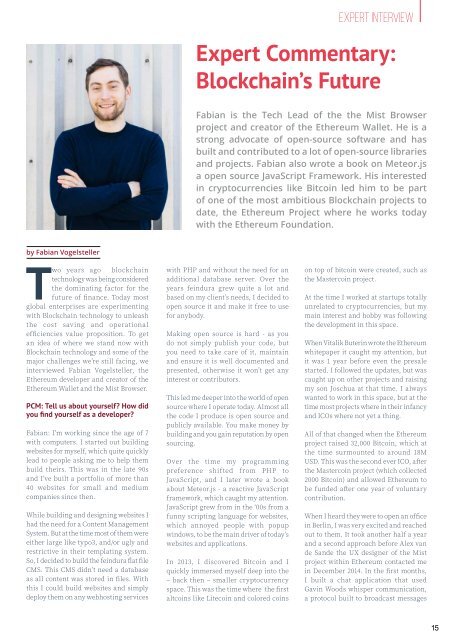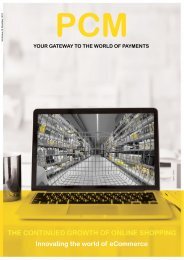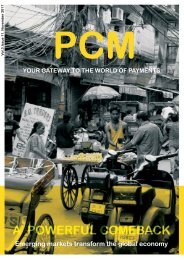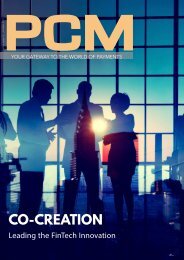PCM vol. 3 issue 5
The fifth issue of the Payments & Cards eMagazine \"PCM\". In this issue, we dive into the realm of Blockchain Technology and Cryptocurrency. Contributions from Ledger, Ethereum, OB1, Crypto Media Hub, Ripple Labs Inc., Wyre, OLX Group and Loyyal.
The fifth issue of the Payments & Cards eMagazine \"PCM\". In this issue, we dive into the realm of Blockchain Technology and Cryptocurrency. Contributions from Ledger, Ethereum, OB1, Crypto Media Hub, Ripple Labs Inc., Wyre, OLX Group and Loyyal.
Create successful ePaper yourself
Turn your PDF publications into a flip-book with our unique Google optimized e-Paper software.
expert interview<br />
Expert Commentary:<br />
Blockchain’s Future<br />
Fabian is the Tech Lead of the the Mist Browser<br />
project and creator of the Ethereum Wallet. He is a<br />
strong advocate of open-source software and has<br />
built and contributed to a lot of open-source libraries<br />
and projects. Fabian also wrote a book on Meteor.js<br />
a open source JavaScript Framework. His interested<br />
in cryptocurrencies like Bitcoin led him to be part<br />
of one of the most ambitious Blockchain projects to<br />
date, the Ethereum Project where he works today<br />
with the Ethereum Foundation.<br />
by Fabian Vogelsteller<br />
Two years ago blockchain<br />
technology was being considered<br />
the dominating factor for the<br />
future of finance. Today most<br />
global enterprises are experimenting<br />
with Blockchain technology to unleash<br />
the cost saving and operational<br />
efficiencies value proposition. To get<br />
an idea of where we stand now with<br />
Blockchain technology and some of the<br />
major challenges we’re still facing, we<br />
interviewed Fabian Vogelsteller, the<br />
Ethereum developer and creator of the<br />
Ethereum Wallet and the Mist Browser.<br />
<strong>PCM</strong>: Tell us about yourself? How did<br />
you find yourself as a developer?<br />
Fabian: I’m working since the age of 7<br />
with computers. I started out building<br />
websites for myself, which quite quickly<br />
lead to people asking me to help them<br />
build theirs. This was in the late 90s<br />
and I’ve built a portfolio of more than<br />
40 websites for small and medium<br />
companies since then.<br />
While building and designing websites I<br />
had the need for a Content Management<br />
System. But at the time most of them were<br />
either large like typo3, and/or ugly and<br />
restrictive in their templating system.<br />
So, I decided to build the feindura flat file<br />
CMS. This CMS didn’t need a database<br />
as all content was stored in files. With<br />
this I could build websites and simply<br />
deploy them on any webhosting services<br />
with PHP and without the need for an<br />
additional database server. Over the<br />
years feindura grew quite a lot and<br />
based on my client’s needs, I decided to<br />
open source it and make it free to use<br />
for anybody.<br />
Making open source is hard - as you<br />
do not simply publish your code, but<br />
you need to take care of it, maintain<br />
and ensure it is well documented and<br />
presented, otherwise it won’t get any<br />
interest or contributors.<br />
This led me deeper into the world of open<br />
source where I operate today. Almost all<br />
the code I produce is open source and<br />
publicly available. You make money by<br />
building and you gain reputation by open<br />
sourcing.<br />
Over the time my programming<br />
preference shifted from PHP to<br />
JavaScript, and I later wrote a book<br />
about Meteor.js - a reactive JavaScript<br />
framework, which caught my attention.<br />
JavaScript grew from in the ‘00s from a<br />
funny scripting language for websites,<br />
which annoyed people with popup<br />
windows, to be the main driver of today’s<br />
websites and applications.<br />
In 2013, I discovered Bitcoin and I<br />
quickly immersed myself deep into the<br />
– back then – smaller cryptocurrency<br />
space. This was the time where the first<br />
altcoins like Litecoin and colored coins<br />
on top of bitcoin were created, such as<br />
the Mastercoin project.<br />
At the time I worked at startups totally<br />
unrelated to cryptocurrencies, but my<br />
main interest and hobby was following<br />
the development in this space.<br />
When Vitalik Buterin wrote the Ethereum<br />
whitepaper it caught my attention, but<br />
it was 1 year before even the presale<br />
started. I followed the updates, but was<br />
caught up on other projects and raising<br />
my son Joschua at that time. I always<br />
wanted to work in this space, but at the<br />
time most projects where in their infancy<br />
and ICOs where not yet a thing.<br />
All of that changed when the Ethereum<br />
project raised 32,000 Bitcoin, which at<br />
the time surmounted to around 18M<br />
USD. This was the second ever ICO, after<br />
the Mastercoin project (which collected<br />
2000 Bitcoin) and allowed Ethereum to<br />
be funded after one year of <strong>vol</strong>untary<br />
contribution.<br />
When I heard they were to open an office<br />
in Berlin, I was very excited and reached<br />
out to them. It took another half a year<br />
and a second approach before Alex van<br />
de Sande the UX designer of the Mist<br />
project within Ethereum contacted me<br />
in December 2014. In the first months,<br />
I built a chat application that used<br />
Gavin Woods whisper communication,<br />
a protocol built to broadcast messages<br />
15

















